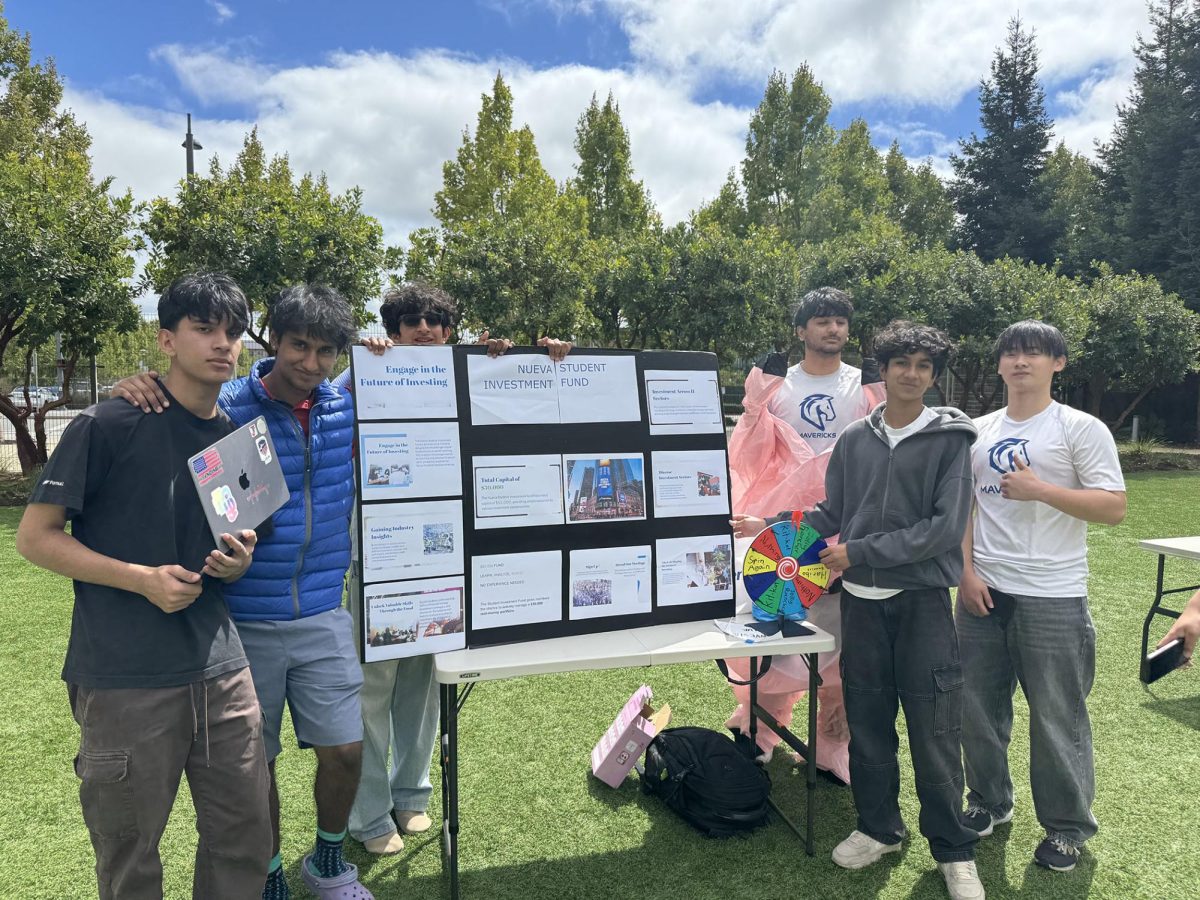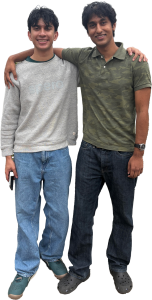
Niam K. ’26
New Club on the Block. The Investment Club debuted at the fall Clubs Fair and currently has 54 members.
After two years of pitching, planning, and fine-tuning their vision, Aadit B. ’26 and Jaisimh R. ’26 have turned an ambitious idea into a reality: a student-led investment club that trades with real capital. Thanks to a $50,000 donation, the Upper School Investment Club will give students hands-on experience in managing a live portfolio—bridging the gap between classroom theory and practical application. It’s a live demonstration of the school’s Learn by doing, Learn by caring motto.
“The focal point of the club is an educational asset to Nueva,” Aadit said. “Our goal and our mission statement are to educate. It’s not to make money.”
Both Aadit and Jaisimh have long been interested in finance and economics, but until now, they have not found a meaningful way to apply the economic theories they have learned in class to the real world.

“Since there’s a lot more to this process that we wanted to learn about, Aadit and I thought that making a club accessible to everyone would be a great opportunity for learning,” Jaisimh said.
The initial concept for the club combined two core components: stock pitching and portfolio management. Members would meet weekly to present in-depth proposals of specific companies, and ultimately make investment cases supported by both financial data and industry context. The club would incorporate both qualitative insight and quantitative rigor.
In February 2024, Aadit and Jaisimh brought a formal proposal to Brett Dyer, Nueva’s Director of Finance and Administration, requesting $50,000 from the school board’s endowment committee. While the amount and the request initially raised eyebrows, Dyer said the students’ pitch made a strong case.
“As they described the level of interest and need to bifurcate investments into different sectors and portfolios, it became apparent that they needed that much,” Dyer said. “If you only had $1,000 in a portfolio that size, it would get used up in transactional fees much faster than the $50,000.”
To further develop their plan, Dyer referred the students to Upper School math teacher Ted Theodosopoulos, who also teaches economics electives. Theodosopoulos recommended they take his Financial Econometrics class, and they began preparing practice presentations with his guidance.
Over the next three months, Aadit and Jaisimh refined their pitch with a series of practice presentations and revisions under the guidance of Theodosopoulos, until the next board meeting in February 2025. Then, the pair presented again to the board, which offered Aadit and Jaisimh a series of questions and improvements before the next board meeting in June.
“I felt thankful for the opportunity to meet with the board,” Barde said. “It felt like we were finally making big steps on this endeavor that we had been working on for so long.”
As summer approached, though, the two saw a different opportunity: raising the funds independently. They felt it would be more efficient, as they would have more agency over the learning structure and would be able to run the club at the start of the new school year.
Word began circulating about the club’s vision—a student-run fund focused on real-world learning. Soon after, a prospective donor expressed interest. Head of School Lee Fertig helped facilitate a meeting between the students and the donor, who was drawn to the educational potential of their project.
“I think that the donor was looking for an opportunity to support student learning about investment,” Fertig said. “I thought it was a very generous gesture.”
Following the meeting, the donor offered feedback—and funding. The one key suggestion: organize the club around the Global Industry Classification Standard (GICS) sectors, with members assigned to specific sectors and a student lead overseeing each group. Aadit and Jaisimh responded quickly, revising their structure and returning with an updated plan that reflected the donor’s feedback.
“[Aadit and Jaisimh’s] responsiveness was a big part of the assurance that the money would be put to good use,” Fertig said. “They responded and said, ‘That makes sense. That’s good feedback. Let’s change our structure, how we’re going to do this, how we would invest, how we would share our learning with each other, and you.’ I think that responsiveness went a long way.”
By August, the $50,000 donation was finalized—not as traditional club funding for snacks or events, but as capital to be actively managed by students with Dyer present to prevent irrational judgments, allowing the club members to experience the market hands-on. The fund will be used solely for investment purposes, housed in a portfolio account, and monitored with professional standards.
To invest in a stock, each sector team must pitch to the rest of the club by presenting statistics and risk analysis, and then the club must vote on whether to invest. Each sector team conducts research, pitches stocks, and makes decisions collaboratively, simulating the structure of real investment teams. If approved, co-leads Aadit and Jaisimh will pass along the recommendation to Theodosopoulos. Once Theodosopoulos reviews and supports the investment, he submits it to Dyer, who places the order.
Fertig drew a clear distinction between this gift and other, more traditional club funding, noting the donor was interested in a way to support “a very specific type of learning.”
“[The donor] wanted to make learning about investment real for students, not to fund the club,” Fertig explained.
Aadit and Jaisimh have structured the club to ensure its sustainability beyond their time at Nueva. Three juniors currently serve as Vice Presidents and will take over the club next year.
“We hope this can be something that grows year after year, something we can come back to in 10 years and it’s still around,” Jaisimh said.